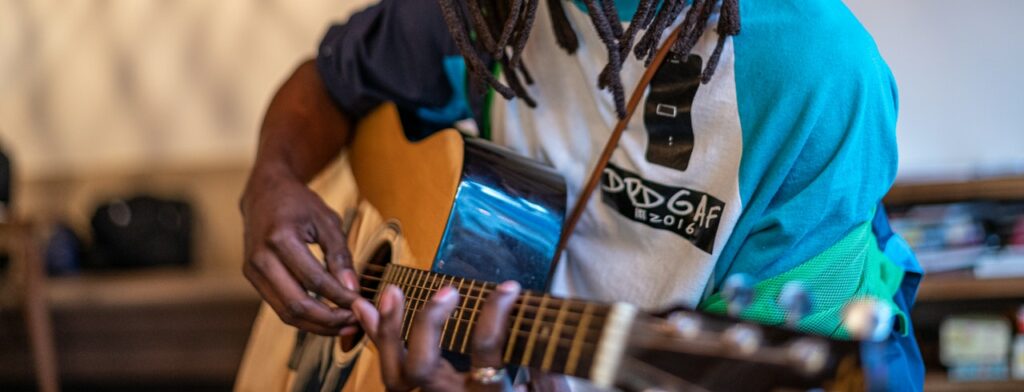Psychoacoustics is the science of how we perceive sound. Scientists and psychologists have been studying the psychological and emotional effects of sound on the human psyche for decades, especially the mood-altering effects of music. Each new study into psychoacoustics reveals new insights and indeed new layers of complexity because sound perception is ultimately uniquely personal, based on life experience, personality traits, and even culture.
However, we can simplify psychoacoustics with some generalizations that are essential fundamentals to know for music composition and production.
Psychoacoustics For Composing Emotional Music
Composers can set the emotional tone of a piece of music by choosing certain chord types to begin the piece and then progressing through chords to create a pattern that achieves the desired mood.
Major chords are generally bright and produce positive emotions, while minor chords invoke sadness and melancholy emotions.

For a nostalgic mix of happiness and sadness, you’d usually progress from a major chord to a minor, a process commonly referred to as ‘modal mixture’. For a deeply depressing song, you might only use minor chord progressions. Dominant 7 chords give you a funky feel with an edge of sexiness. For romantic music, you need a mix of major with minor 7 and/or major 7 chords.
The variety of possible chord progressions is as infinite as the nuances of human emotion. Everyday sounds also provoke emotional responses, but the listener’s reaction depends on personal memories or emotions that they associate with each sound. It’s worth remembering the importance of using silence when mixing a song. Silence and pauses also generate emotions, as they alert the listener to what comes next.
Sound’s Journey From Ear To Brain
Our ear drums sense minute changes in air pressure created by soundwaves. The changes in pressure are converted into nervous signals that are transmitted to the brain along the central auditory pathway (vestibulocochlear nerve). Music has such a significant impact on our emotional state because the neurotransmitter for sound is dopamine, which regulates moods and emotional behavior.
Five Essential Elements Of Psychoacoustic Music Production
Experienced music producers are masters of psychoacoustics. They shape the sound of individual instruments to invoke emotional responses in the listener. To really tug at the heartstrings, individual sounds should be clearly identifiable in a context that paints a rich tapestry of texture and color that feels authentic. Achieving that high level of clarity, professional audio engineers primarily focus on five specific elements of sound: frequency, wavelength, amplitude, timbre, and spatial location.

Frequency And Wavelength
The frequency of a sound wave determines its pitch. We use hertz (Hz) as a measurement of the time and distance between each crest of the sound wave, also called an oscillatory cycle. The Hertz scale goes from one oscillatory cycle per second (1 Hz) up to thousands of cycles per second (kHz).
For example, 20 Hz is a very low frequency with a long wavelength of about 17 meters between each crest of the sound wave, whereas 20 kHz is a very high frequency with a much shorter wavelength of about 17 mm.
Amplitude
Amplitude is the magnitude of pressure at the crest of a sound wave compared to the low-pressure trough of the wave. Although air pressure is usually measured in pascals, sound waves are measured in decibels (dB or dBSPL) based on the range of frequencies heard by the human ear.
The amplitude of a whisper is about 30 dB. Normal conversation is about twice that (60 dB). The noise of an engine reaches almost 100 dB, which can damage our ears over a prolonged period. Loud noises over 120 dB can cause instant and permanent harm and hearing loss or tinnitus.
Timbre
Timbre relates to the perceived quality of sounds, which we discern or identify by the way the waveform changes over time. We’re talking fractions of seconds here, but within those split seconds, we can recognize the loudness and harmonic content of different instruments. Just as we discern natural sounds such as wind and birdsong, this ability allows us to tell the difference between a cello and a violin or a saxophone and a clarinet.
Sonic Texture
Simply put, sonic texture is the mix of sound sources and the way they interact with each other to create depth in a mix. The more instruments or voices that you add to a piece of music, the busier it becomes. Too many layers make music sound muddy, so it’s the sound engineer’s job to maintain clarity in the texture by ensuring each instrument can be distinctly heard rather than being confronted by an indiscernible splattering of sound.
Spatial Location
In everyday life, we are quite adept at identifying and locating sound sources among other sounds using a combination of spatial location and timbre identification. We can pick out individual instruments in an orchestra or someone’s voice in a crowded room of chattering people.
How To Enhance Music Production With Psychoacoustics
To give music the desired emotional impact, all the elements of sound that we’ve just discussed should be balanced so that individual instruments shine through without overlapping each other (frequency masking).
Create A Proper Recording Environment
Starting with a good recording is essential in creating music with a solid foundation for enhancing your psychoacoustics. Don’t cut corners here. Do what’s necessary to create a studio environment with soundproofing and sound-absorbing materials. You don’t have to spend a fortune, but you do need to make the effort to eliminate unwanted echo or sound pollution from other sources inside and outside the room.
Unmask Instruments With EQ Settings
Every instrument or voice has its own distinct frequency range, but similar-sounding instruments can obscure or mask each other and muddy the mix. Unmask them by altering the EQ of one or more of the troublesome tracks to differentiate the frequencies and add clarity to the mix. For example, you might want to sharpen up a kick drum obscured by another bass drum by boosting the high end a bit to make it more distinct.
There are no hard and fast rules here and no EQ presets that fit all situations. These are the listening skills that music producers develop with years of experience. If you are new to music production, just get started and begin experimenting. You’ll learn by doing.

Eliminate Unwanted Frequencies
Ultrasonic waves are high-pitched frequencies that are beyond the range of our hearing, but we can still sense them. Over an extended period, they become irritating to the point of causing stress and headaches. To remove any ultrasonic sound from your production, you should use a high-cut filter to eliminate frequencies above 20 kHz.
The same goes for infrasound waves below 20 Hz, which are too low for human ears but can still be heard by some animals. Although we can’t hear those low frequencies, we sense them as a negative vibe. In this case, use a low-cut filter to eliminate those inaudible bass frequencies.
Create Space In Your Music Production
One of the secrets to successful psychoacoustics is creating authentic-sounding 3D audio environments by spreading sounds around to give you a soundscape that has breadth and depth.
Start off with your tracks in mono so that you have a clear soundscape to build on. This allows you to hear more easily whether there is any frequency masking before you progress with your mix. Move sounds around by playing with the panning and balance of individual tracks. Position each in a different spatial location so they don’t overlap.
Add Depth And Texture To Your Soundscape
Producers often add depth by doubling or even quadrupling individual tracks and spreading them across the soundscape. Once cloned, you can add texture to those additional tracks and differentiate each from the others by tweaking tone and pitch as well as adding volume or using reverb and delay plugins on individual tracks.
For that final touch of psychoacoustic magic, use effects such as chorus, phaser, and flanger plugins. Use them sparingly and only on single tracks to give them depth wherever necessary. Don’t add these effects to bundles of tracks; otherwise, you’ll end up with a messy and confusing sound.
Conclusion: Psychoacoustics Is Music Science That Really Works
Some modern pop songs stand out as glorious examples of psychoacoustic science. The nostalgic key changes we discussed earlier (modal mixture) have served as a surefire formula for building music to a heart-wrenching climax for more than a century. One example is the song ‘All By Myself’, which former frontman of The Raspberries, Eric Carmen, wrote and composed, and Celine Dion further popularized. Eric based the song’s verses on the second movement of Sergei Rachmaninoff’s Piano Concerto No. 2, completed in 1901. Critics consider it Rachmaninoff’s finest work, which he ironically dedicated to his hypnotherapist.
Celine Dion usually starts her live version of ‘All By Myself’ in G Major (bright), harmonized with G Minor (dark). She progresses through more melancholy minor chords, resolving with enormous emotional release from a key change back to G Major on the flat 6. Eternal oldies like ‘White Christmas’ (1954) also feature this modal mixture for that timeless touch of nostalgia.
You can combine and adapt these chord progression and key change formulas in your compositions and productions in myriad ways. Finding that magical chord progression and focusing on those five essential production elements using unique EQ settings can make all the difference in creating your magnum opus.
Leave a comment
Log in to comment


